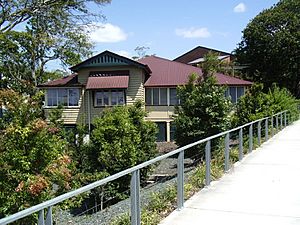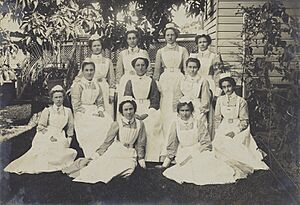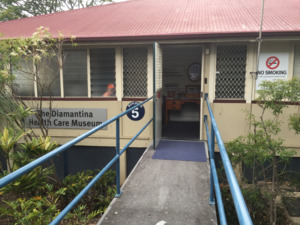Diamantina Health Care Museum facts for kids
Quick facts for kids Diamantina Health Care Museum |
|
|---|---|

Former Dispenser's House, Diamantina Hospital
|
|
| Location | Cornwall Street, Woolloongabba, City of Brisbane, Queensland, Australia |
| Design period | 1900–1914 (early 20th century) |
| Built | 1908 |
| Architect | Thomas Pye of Queensland Government Architect's Office |
| Official name: Former Dispenser's House, Diamantina Hospital, Diamantina Health Care Museum | |
| Type | state heritage (built) |
| Designated | 3 July 2007 |
| Reference no. | 602560 |
| Significant period | 1908–1974 |
| Significant components | residential accommodation – other |
| Builders | W Chaplain |
| Lua error in Module:Location_map at line 420: attempt to index field 'wikibase' (a nil value). | |
The Diamantina Health Care Museum is a special building in Woolloongabba, Brisbane, Queensland, Australia. It used to be called the Dispenser's House of Diamantina Hospital. This historic building was designed by Thomas Pye and built in 1908. Today, it's a museum that teaches us about health care history. It was officially recognized as a heritage-listed site on 3 July 2007.
Contents
History of the Museum Building
The building that is now the Diamantina Health Care Museum was built in 1908. It was originally part of the Diamantina Hospital for Chronic Diseases. This hospital helped people with long-term illnesses.
From Orphanage to Hospital
The Diamantina Hospital started in 1901. It used buildings that were once the Diamantina Orphanage. This orphanage was named after Lady Diamantina Bowen, the wife of Queensland's first Governor.
The orphanage began in 1864 in two small cottages. These cottages were near the Victoria Barracks and had been used as a fever hospital. By 1866, the orphanage cared for about 100 children. The government helped support it.
In 1882, a larger piece of land was bought in Woolloongabba. The new Diamantina Orphanage opened there in 1883. By 1886, it looked after more than 350 children.
In 1893, floods damaged another facility, the Woogaroo Lunatic Asylum. About 40 patients from there moved to the orphanage. The children were then moved to other places. From 1898 to 1900, the building was used as a reformatory for boys.
A New Kind of Hospital
At that time, Queensland did not have a hospital for people with long-term illnesses. Tuberculosis was a big problem and a major cause of death. People believed that warm weather could help cure this disease. Doctors wanted a special place to treat these patients.
A sanatorium, a type of hospital, opened in Dalby in 1900. The Diamantina Orphanage buildings were then changed into a hospital. Its dormitories became wards for patients.
On 5 August 1901, it opened as the Diamantina Hospital for Chronic Diseases. It was a public charity hospital. It took patients from other hospitals, many of whom had tuberculosis. The hospital started with 32 beds and 19 staff members. Miss Florence Chatfield was the Matron, and Dr Francis Hare was the Superintendent. Mr Frederick Staubwasser was the Head Wardsman and Dispenser.
The Dispenser's House is Built
By 1903, the hospital had 72 beds. Mr Staubwasser, the Dispenser, wanted a raise and a house on the hospital grounds in 1907. Matron Chatfield strongly supported his request. She wrote to the government, saying how important he was.
His request was approved. Thomas Pye, the Deputy Government Architect, drew plans for a house. It would have a large front verandah. Construction began in 1908, and the house was ready by early 1909.
Mr Staubwasser lived in the house and worked as Dispenser until 1912. He then became Assistant Superintendent. More verandahs were added to the house in 1912 and 1923. A laundry was added in 1914. In 1935, Mr Staubwasser became Superintendent. He lived in the house until he passed away in 1938.
After 1938, other medical officers lived in the house. They were in charge of the Diamantina Hospital patients.
Changes Over Time
In 1943, the Diamantina Hospital became the South Brisbane Auxiliary Hospital. It was managed by the Brisbane General Hospital. After World War II, the government worked hard to stop tuberculosis. This meant fewer people needed long-term care.
In 1956, a new, larger hospital was built on the grounds. In 1960, it was renamed the Princess Alexandra Hospital.
The Dispenser's House was used by different staff members. In 1974, it became a training center for home kidney dialysis. Later, it was used by history and redevelopment groups.
In 2003, the old Dispenser's House was renovated. It opened in 2004 as the Diamantina Health Care Museum.
What the Museum Looks Like
The Diamantina Health Care Museum is near the Cornwall Street entrance of the Princess Alexandra Hospital. It is a timber building with a hipped roof made of corrugated iron. It stands on new concrete stumps.
The building has a gabled section with four windows on the eastern side. There are verandahs on the north and south sides. The southern verandah has timber-framed windows. The northern verandah has glass louvres.
Inside, the walls, floors, and ceilings are made of timber. Some rooms have French doors with small windows above them. Modern toilets have been added. The building still looks much like a home.
Why the Museum is Heritage-Listed
The former Dispenser's House of the Diamantina Hospital was added to the Queensland Heritage Register on 3 July 2007. This means it is a very important historical site.
Showing Queensland's History
This building helps us understand the history of health care in Queensland. The Diamantina Hospital was the first of its kind in the state. It was important for treating long-term illnesses. The house also shows that it was common for important hospital staff to live on site back then.
A Rare Piece of History
The former Dispenser's House is now rare. It is the only building left from the original Diamantina Hospital for Chronic Diseases.



